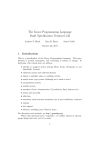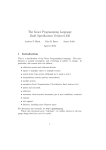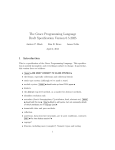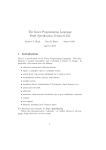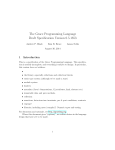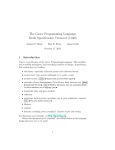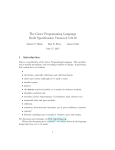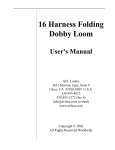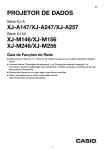Download Grace language specification v0.095
Transcript
The Grace Programming Language
Draft Specification Version 0.095
Andrew P. Black
Kim B. Bruce
James Noble
February 22, 2011
1
Introduction
This is a specification of the Grace Programming Language. This specification is notably incomplete, and everything is subject to change. In
particular, this version does not address:
• whether to support object nesting (Beta, Scala, Newspeak) or not
(Smalltalk, Python).
• static type system
• encapsulation system
• module system
• collection syntax and collection literals
• annotations
• purity and non-nulls.
• reflection
• assertions, data-structure invariants, pre & post conditions, contracts
• regexps
• libraries
For discussion and rationale, see http://gracelang.org.
Where this document gives “(options)”, we outline choices in the language design that have yet to be made.
1
Id: spec.tex 93 2011-02-21 11:39:46Z kjx
2
2
User Model
All designers in fact have user and use models consciously
or subconsciously in mind as they work. Team design. . . requires
explicit models and assumptions.
Frederick P. Brooks, The Design of Design. 2010.
1. First year university students learning programming in CS1 and CS2
classes that are based on object-oriented programming.
(a) The courses may be structured objects first, or imperative first.
Is it necessary to support “procedures first”?
(b) The courses may be taught using dynamic types, static types, or
both in combination (in either order).
(c) We aim to offer some (but not necessarily complete) support for
“functional first” curricula, primarily for courses that proceed
rapidly to imperative and object-oriented programming.
2. University students taking second year classes in programming; algorithms and data structures, concurrent programming, software craft,
and software design.
3. Faculty and teaching assistants developing libraries, frameworks, examples, problems and solutions, for first and second year programming
classes.
4. Programming language researchers needing a contemporary objectoriented programming language as a research vehicle.
5. Designers of other programming or scripting languages in search of a
good example of contemporary OO language design.
Id: spec.tex 93 2011-02-21 11:39:46Z kjx
3
3
Syntax
Much of the following text assumes the reader has a minimal
grasp of computer terminology and a “feeling” for the structure
of a program.
Kathleen Jensen and Niklaus Wirth, Pascal: User Manual and Report.
Grace programs are written in UTF-8. Reserved words and the names of
library methods are written in the ASCII subset of UTF-8.
3.1
Layout
Grace uses curly brackets for grouping, and semicolons as statement terminators. Grace also uses indentation (layout) for grouping, and infers semicolons at the end of lines. If code uses both layout and braces, then it’s a
syntax error for them not to agree.
code with punctuation:
while {stream.hasNext} do {
print (stream.read );
};
code with layout:
while
stream.hasNext
do
print (stream.read)
code with both:
while {stream.hasNext} do
print (stream.read)
3.2
Comments
Grace’s comments delimiters follow C++ and Java. However, comments are
not treated as white-space; each comment is conceptually attached to the
smallest immediately preceeding syntactic unit.
// comment to end−of−line
/∗ comment to close comment ∗/
Id: spec.tex 93 2011-02-21 11:39:46Z kjx
3.3
4
Identifiers
Identifiers in Grace must begin with a letter and consist of letters and digits
thereafter.
(option) Prime ’ and underscore characters _ may be used after the first
character of an identifier.
3.4
Reserved Words
The ? indicates words related to design options not yet chosen.
self super? true false method const var next? outer? prefix? constructor?
object class extends type
3.5
Tabs and Control Characters
Newline can be represented either by carriage return or by line feed; however,
a line feed that immediately follows a carriage return is ignored.
Tabs and all other non-printing control characters (except carriage and
line feed) are syntax errors.
4
Built-in Objects
4.1
Numbers
All numeric types are sub-types of an abstract type Number. All Grace
implementations must support both exact Rational and IEEE754.Binary64
floating point numbers. Implementations may support other numeric types.
Grace has three syntactic forms for numerals (literals that denote Numbers):
1. decimal numerals, written as strings of digits, optionally preceded by
a minus;
2. explicit radix numerals, written as a (decimal) number between 2 and
35 representing the radix, a leading x, and a string of digits, where the
digits from 10 to 35 are represented by the letters A to Z, in either
upper or lower case. As a special case, a radix of 0 is taken to mean a
radix of 16. Explicit radix numerals may not be preceded by a minus.
3. base-exponent numerals, always in decimal, which use e as the exponent indicator. Base-exponent numerals may be preceded by a minus.
Id: spec.tex 93 2011-02-21 11:39:46Z kjx
5
All literals evaluate to exact Rational numbers; explicit conversions (such as
b64) must be used to convert rationals to other types.
Examples
1
−1
42
3.14159265
13.343e−12
−414.45e3
16xF00F00
2x10110100
0xdeadbeef // Radix zero treated as 16
4.2
Booleans
The leywords true and false denote the only two values of Grace’s Boolean
type. Boolean operators will generally be written using single characters &
for and, | for or.
“Short circuit” (a.k.a non-commutative) boolean operators use keyword
messages that take blocks as their second arguments.
Examples
P&Q
toBe | toBe.not
container .nonEmpty.and {container. first = sought}
4.3
Strings and Characters
String literals in Grace are written between double quotes, as in C, Java,
and Python. Strings literals support a range of escape characters such as
”\t\b\n\f\r\v\\\””, and also escapes for Unicode. Individual characters
are represented by Strings of length 1. Strings are immutable Grace values
(see §10) and so may be interned. Strings conform to the protocol of an
immutable IndexableCollection, and Grace’s standard library will include
mechanisms to support efficient incremental string construction.
Id: spec.tex 93 2011-02-21 11:39:46Z kjx
6
Examples
”Hello World!”
”\t”
”The End of the Line\n”
”A”
4.4
(option) String interpolation
We are considering syntax so that strings (or expressions returning objects
that support the asString method) can be directly interpolated into strings.
Examples
”Adding {a} to {b} gives {a+b}”
5
Blocks
Grace blocks are parameterless lambda expressions. Blocks with parameters
have a formal parameter list terminated by the => symbol.
Blocks are evaluated by sending them the message apply1
{ print ”Hello World” }
if (x = 3)
print ”Three!”
for 1..10 do
i => print i
var sum := 0
const summingBlock : Block<Number,Number> =
{ i :Number => sum := sum + i }
summingBlock.apply(4)
// sum is now 4
summingBlock.apply(32)
// sum ins now 36
Blocks are lexically scoped inside their containing method, or block. A
“naked” block literal that is neither the target of a message send nor passed
as an argument is a syntax error.
The body of a block consists of a sequence of declarations and expressions
(option) and also statements, if we have them.
1
Isn’t apply overloaded and variadic?
Id: spec.tex 93 2011-02-21 11:39:46Z kjx
6
7
Declarations
Const and var declarations may occur anywhere within a method or block:
their scope is to the end of their defining block or method.
6.1
Constants
Constants bind an identifier to the value of an initializer expression, optionally at a precise type.
Examples
const
const
const
const
x = 3 ∗ 100 ∗ 0.01
x: Rational = 3 // probably means the same as the above
x:Binary64 = 3
x: Rational // Syntax Error : x must be initialised
Grace has a single namespace for methods and constants (and variables).
A constant declaration of x can be seen as creating a (nullary) accessor
method x.
6.2
Variables
Grace supports variable declarations using the “var” keyword.
Uninitialized variables (of any type) are given a special “uninitialized”
value; accessing this value is an error (caught either at run time or at compile
time, depending on the cleverness of your implementor).
Examples
var x := 3
var x: Rational := 3
var x:Binary64 := 3
// type of x is inferred .
// explicit type.
// explicit type
Variables are reassigned using assignment methods (see §8.2). A variable declaration of “x” can be seen as creating an accessor method “x” and
an assignment method “x:=” Grace’s encapsulation system will control the
accessibility of each of these methods.
6.3
Methods
Methods are declared with the “method” keyword, a name, optionally an
argument list, potentially repeated, optionally a return type declaration,
Id: spec.tex 93 2011-02-21 11:39:46Z kjx
8
and a method body. Where a method body is a single expression, it may be
introduced by an “=” and the body needs no “return” statement.
Assignment methods are named by an identifier suffixed with “:=”. If
supported, prefix operator methods will be named “prefix” followed by the
operator character(s).
Examples
method pi = 3.141592634
method greetUser {print ‘‘ Hello World!’’}
method +(other : Point) : Point = { (x+other.x) @ (y+other.y) }
method + other
(x+other.x) @ (y+other.y)
method +(other)
return (x+other.x) @ (y+other.y)
method foo:=(n : Number) returns Void
print ”Foo currently {foo}, now assigned {n}”
super.foo:= n
method choseBetween (a : Block<Void>) and (b : Block<Void>) returns Void
if Random.nextBoolean
then {a.apply} else {b.apply}
class Number {
method prefix− returns Number = {0 − self}
}
7
Objects and Classes
Grace object constructor expressions and declarations produce individual
objects. Grace provides class declarations to create classes of objects all
with the same structure.
Grace’s class and inheritance design is not yet complete. In particular,
details of multiple factory methods, and factory methods across inheritance
hierarchies are likely to change.
Id: spec.tex 93 2011-02-21 11:39:46Z kjx
7.1
9
Objects
Objects are created by primitive object constructor literals. The body of an
object constructor literal consists of a sequence of declarations.
object
const color : Color = Color.tabby
const name : String = ”Unnamed”
var miceEaten := 0
Objects constructors are lexically scoped inside their containing method,
or block. In particular, any initializer expressions on fields or constants are
executed in that lexical context. (The durability of that link is the “nesting”
question, see §1). Each time an object constructor is executed, a new object
is created.
A constant initialized by an object constructor, such as
const unnamedCat = object
const color : Color = Color.tabby
const name : String = ”Unnamed”
var miceEaten := 0
evaluates that constructor just once, and repeated invocations of the reader
method unnamedCat will return the same object. This may be abbreviated
with a named object declaration that creates a singleton object.
object unnamedCat
const color : Color = Color.tabby
const name : String = ”Unnamed”
var miceEaten := 0
7.2
Classes
Objects declarations have no provision for initialising objects other than
lexical scope. Class declarations combine the definition of an object with
the definition of a factory object with a method that creates instances of the
class. A class declaration is similar to a named object declaration, except
that it may have one or more methods annotated <factory>:
Examples
class Cat
const color : Color
Id: spec.tex 93 2011-02-21 11:39:46Z kjx
10
const name : String
var miceEaten := 0
<factory> newUnnamedTabby() returns Cat
return new(Color.tabby, ”Unnamed”)
<primary factory> new(color : Colour, name : String ) returns Cat
A primary factory method has no body; it creates a new object, with its
constants and variables inititalized from the method’s lexical scope. That
is, in the above example, the constants color and name are initialised from
the parameters of new with the same names. Other factory methods may
create objects by calling the primary factory method.
The new object that is created is the object that one gets by:
1. replacing the keyword class with object,
2. and deleting the factory attributes.
New instances of the class — new objects of the above shape — are
created in the program by sending one of the factory messages to the factory
object.
Examples
const stray = Cat.newUnnamedTabby // create new unnamed cat
const fergus = Cat.new(” tortoiseshell ”, ”Fergus Trouble”)
7.3
Inheritance
Grace class declarations supports inheritance with “single subclassing, multiple subtyping” as in Java. A new declaration of a method or field can
override an existing definition — overriding declarations must be declared
<override>, and overridden defintions can be accessed via super calls §8.5.
It is a static error for a field to override another field or a method. This
example shows how a subclass can override accessor methods for a variable defined in a superclass (in this case, to always return 0 and to ignore
assignments).
class PedigreeCat extends Cat implements CatShowExhibit
var prizes = 0
<override> method miceEaten = 0;
<override> method miceEaten:=(n :Number) {return} //Just forget
<factory> new(color : Colour, name : String ) : Cat {}
Id: spec.tex 93 2011-02-21 11:39:46Z kjx
11
Note that a subclasses’ factory method should initialize not just its own
uninitialized fields, but all uninitialized fields declared in its superclasses.
(see 6.2)
8
Method Calls
Grace is a pure object-oriented language. Everything in the language is
an object, and all computation proceeds by calling dynamically dispatched
methods on objects.
8.1
Named Method
A named method call is a receiver followed by a dot “.”, then a method
name (an identifier), then any arguments in parentheses. If there are no
arguments, or only one argument, the parentheses may be omitted. A long
argument list may be divided by additional “keyword” method names. A
named method call with an implicit receiver omits the receiver and the dot.
graphicsContext .drawLineFrom(source) to( destination )
graphicsContext .movePenTo(x,y)
print (”Hello world”)
print ”Hello world”
pt.x()
pt.x
Grace does not allow overloading on argument type. Grace (currently)
does not support variadic methods.
8.2
Assignment Method
A assignment method call is an explicit receiver followed by a dot, then a
message name (an identifier) directly followed by “:=”, and then a single
argument. An assignment method call with an implicit receiver omits the
receiver and the dot.
x := 3
y:=2
widget. active := true
Id: spec.tex 93 2011-02-21 11:39:46Z kjx
8.3
12
Binary Operator Method
Grace also allows operator symbols (sequences of operator characters) for
binary messages — with an explicit receiver and one argument. An operator
method name is one or more operator characters, and may not match a
reserved symbol (for example “.” is reserved, but “ .. ” is not). All Grace
operators have the same precedence: it is a syntax error for two different
operator symbols to appear in an expression without parenthesis to indicate
order or evaluation. The same operator symbol can be sent more than once
without parenthesis and is evaluated left-to-right.
1 + 2 + 3 // evaluates to 6
1 + (2 ∗ 3) // evaluates to 7
(1 + 2) ∗ 3 // evaluates to 9
1 + 2 ∗ 3 // syntax error in Grace; would evaluate to 9 in Smalltalk
Named message calls bind more tightly than operator message calls:
The following examples show first the Grace expressions as they would be
written, followed by the parse
1 + 2.i
(a ∗ a) + (b ∗ b). sqrt
((a ∗ a) + (b ∗ b)). sqrt
a ∗a +b∗b
a +b+c
a
b
c
8.4
1 + (2.i )
(a ∗ a) + ((b ∗b). sqrt )
((a ∗ a) + (b ∗b)). sqrt
// syntax error
(a + b) + c
(a
b)
c
(option)Unary Prefix Operator Method
We are considering permitting unary prefix operator methods — since we
do not support binary operator methods with implicit receivers there is no
syntactic ambiguity.
− (b +/− (4 ∗ a ∗ c).sqrt)
status .ok := ! engire fire & !wings attached & on course
Prefix operators would bind tighter than binary operators or other method
calls.
8.5
Super calls
The reserved word super may only be used as an explicit receiver. A “super” call invokes the method that would have been called had the currently
Id: spec.tex 93 2011-02-21 11:39:46Z kjx
13
executing method not been defined.
super.foo
super.bar (1,2,6)
super.doThis(3) timesTo(”foo”)
super + 1
!super
foo(super) // syntax error
1 + super // syntax error
8.6
Encapsulation
The design of Grace’s encapuslation system has not yet begun in earnest.
Grace will support some kind of private methods that can only be called
on self or super.
9
Control Flow
Control flow statements in Grace are syntactically message calls. While
the design of the module system is not complete (not yet begun) we expect
that instructors will need to define domain-specific control flow constructs in
libraries — and these constructs should look the same as the rest of Grace.
9.1
Basic Control Flow
If statements:
if ( test ) then {block}
if ( test ) then {block} else {block}
While statement:
while {test } do {block}
For statement:
for ( collection ) do {each => block}
for (course . students) do { each => print each }
for 0.. n do { i => print i }
Id: spec.tex 93 2011-02-21 11:39:46Z kjx
9.2
14
Case
Grace will support a match/case construct:
match (x)
// match against a literal constant
case { 0 => ”Zero” }
// typematch, binding a variable ’’’ looks like normal parameter passing case ’’’
case { s : String => print(s) }
// match against an existing name − requiring parens like Scala
case { ( pi ) => print(”Pi = ” ++ pi) }
// destructuring match, binding variables ...
case { Some(v) => print(v) }
This is the “pattern-matching-lambda” design (see blog post 10/02/2011).
9.3
Exceptions
Grace supports basic unchecked exceptions. Exceptions will be generated
by the ”raise” keyword with an argument of some subtype of Exception:
raise UserException.new(”Oops...!”)
Exceptions are caught by a “catch / case” statement that syntactically
parallels the “match / case” statement.
catch {File .open(”data.store”)}
case {e : NoSuchFile => print(”No Such File”); return}
case {e : PermissionError => print(”No Such File”); return}
case {Exception => print(”Unidentified Error ); System.exit ()}
Exceptions can’t be restarted, however, the stack frames that are terminated when an exception is raised should be pickled so that they can be
used in the error reporting machinery (debugger, stack trace).
10
Equality and Value Objects
All objects will automatically implement the following methods, and programmers are not able to override them.
1. “=” and “!=” operators implemented as per Henry Baker’s EGAL
predicate.
Id: spec.tex 93 2011-02-21 11:39:46Z kjx
15
2. “hashcode” compatible with the EGAL operators.
As a consequence, immutable objects (no “var” fields, and only containing other immutable objects) will act as pure “value objects”. A Grace
implementation can support value objects using whatever implementation
is most efficient: either passing by reference always, by passing some types
by value, or even by inlining fields into their containing objects, and doing
a field-update if the containing object assigns in a new value.
11
Types
The design of Grace’s type system has not begun in earnest.
We expect to provide type declarations describing objects’ interfaces.
Named object or class declarations will define types with the same name
as object or class begin defined. The various Cat object and class descriptions (see §7) would produce a type such as:
type Cat
color : Color
name : String
miceEaten : Number
miceEaten:=(Number) : Void
1. Classes are not types.
2. Classes define a type (of the same name)
3. Grace will probably use structural subtyping
Acknowledgements
The Scala language specification 2.8 and the Newspeak language specification 0.05 were used as references for early versions of this document. Please
excuse the lack of citations so far in this draft.
Id: spec.tex 93 2011-02-21 11:39:46Z kjx
A
16
To Be Done
As well as the large list in Section 1 of features we haven’t started to design,
this section lists details of the language that remain to be done:
1. specify full layout syntax §3.1
2. decide about variadic methods §8.1 including Block :: apply §5
3. character to separate block args from body => (Scala, C]), −> (Java8,
ML, Haskell), | (Smalltalk, Self, Newspeak) §5
4. consider whether to follow Self message name syntax (second and subsequent keyword must begin with a Capital) §8.1
5. decide about prefix operators §8.4
6. short-circuit boolean operators §4.2
7. string interpolation syntax §4.4
8. confirm operator precedence §8
9. confirm method lookup algorithm, in particular relation between lexical scope and inheritance 8
10. make the const keyword optional, or remove it §6.1
11. how powerful should case be §9.2, see blog post 10/02/2011.
12. still unhappy with inheritance design §7.3
13. where should we draw the lines between object constructor expressions/named object declarations, class declarations, and “hand-built”
classes? §7.3
14. how do factories etc relate to “uninitialized” §6.2
15. what syntax for control structure “arguments” parentheses or braces?
§9.1
16. James is tempted by Ruby style exceptions — where handlers can be
nested at the end of any block. §9.3
17. What is the namespace of types? What is the syntax of types? §11
More to the point, what is the type system?
















